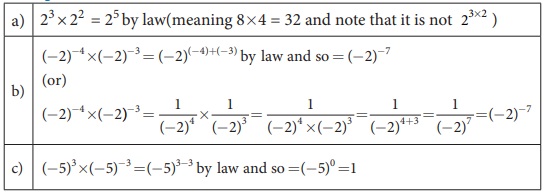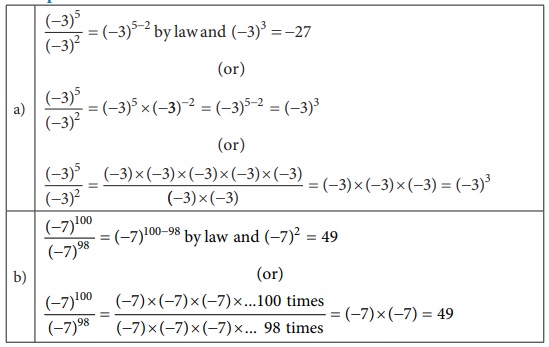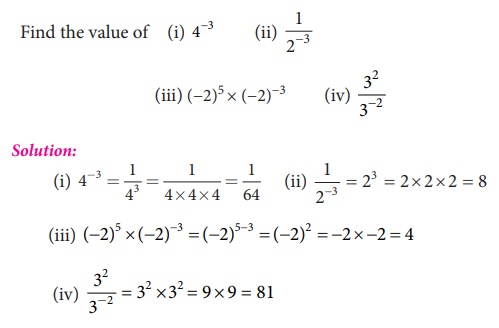Numbers | Chapter 1 | 8th Maths - Exponents and Powers | 8th Maths : Chapter 1 : Numbers
Chapter: 8th Maths : Chapter 1 : Numbers
Exponents and Powers
Exponents
and Powers
We know how
to express some numbers as squares and cubes. For example, we write 52
for 25 and 53 for 125.

In general
terms, an expression that represents repeated multiplication of the same factor
is called a power.
The number 5 is called the base and the number 2 is called the exponent
(more often called as power). The exponent corresponds to the number of times the
base is used as a factor.
1. Powers
with positive exponents
Value of
powers given by positive whole number exponents quite often increase rapidly.
Observe the
following example:
21
=2
22
=
2×2=4
23
=
2×2×2=8
24
=
2×2×2×2
=16
25
=
2×2×2×2×2=32
26
=
2×2×2×2×2×2=64
27
=
2×2×2×2×2×2×2=128
28
=
2×2×2×2×2×2×2×2=256
29
=
2×2×2×2×2×2×2×2×2=512
210
=
2×2×2×2×2×2×2×2×2×2=1024
At this rate
of increase, what do you think 2100 will be?
In fact,
2100=1267650600228229401496703205376
Thus, we
understand that the positive exponential notation with positive power could be useful
when we come across with large numbers.
2. Powers
with zero and negative exponents
Observe this
pattern:
25= 32
24= 16
23= 8
22= 4
21= 2
20=?
Starting
from the beginning, what happens in the successive steps? We find that the result
is half of that of the previous step. So, what can we say about 20 ?
If we prepare a table like this for 35, 34, 33,
and so on what will it tell us about 30? We can use the same process
as in this pattern, to conclude that any non-zero number raised to the zero exponent
must result in 1. Thus,
a0 = 1, where a ≠ 0
Let us see
what happens if we extend the above pattern further downward.
As before,
starting from the beginning, in the successive steps, we find that the result is
half of that of the previous step. Since 20 = 1, the next step is 2–1,
whose value is the previous step’s value 1, divided by 2, that is 1/2 . Next is
2–2, which is the same as 1/2 divided by 2, that is 1/4 and so on. Thus,
23 = 8
22 = 4
21 = 2
20 = 1
2–1 = 1/2
2–2 = 1/4
2–3 = 1/8
In general, a−m = 1/am , where m is an integer

3. Expanded
form of numbers using exponents
In the lower
classes, we have learnt how to write a whole number in the expanded form. For example,
5832 = 5×1000
+ 8×100
+ 3×10
+ 2×1
= 5×103
+ 8×102
+ 3×101
+ 2 (when we use exponential notation).
What shall
we do if we get decimal places? Powers of 10 with negative exponents come to our
rescue!
Thus, 58.32
= 50 + 8 + 3/10 + 2/100
= 5×10 + 8×1 + 3× (1/10) + 2
× (1/100)
= 5×101
+ 8×100
+ 3×10–1
+ 2×10–2
Try these
Expand the following
numbers using exponents:
1.8120 2. 20305
3. 3652.01 4. 9426.521
Solution:
(i) 8120 = (8 × 1000) + (1 × 100) + (2 × 10) + 0 × l
= (8 × 103) +
(1 × 102) + (2 × 101)
(2) 20305 = (2 × 10000) + (0 × 1000) + (3 × 100) + ( 0 × 10) + (5 × 1)
= (2 × 104) +
(3 × 102) + 5
(3) 3652.01 = 3000 + 600 + 50 + 2 + 0/10 + 1/100
= (3 × 1000) + (6 × 100) + (5 × 10) + (2 × 1) + 1 × 1/100)
= (3 × 103) +
(6 × 102) + (5 × 101) + 2 + (1 × 10−2)
(4) 9426.521 = (9 × 1000) + (4 × 100) + (2 × 10) + (6 × 1) + (5/10) +
(2/100) + (1/1000)
= (9 × 103) + (4 × 102) + (2 × 101)
+ 6 + (5 × 10−1) + (2 × 10−2) + (1 × 10−3)
4. Laws
of Exponents
Laws of exponents
arise out of certain basic ideas. A positive exponent of a number indicate how many
times we use that number in a multiplication whereas a negative exponent suggests us how many times we use that number in a division, since the opposite
of multiplying is dividing.
• Product
law
According
to this law, when multiplying two powers that have the same base, we can add the
exponents. That is,
am × an
= am + n
where a (a≠0),
m, n are integers. Note that the base should be the same in both the quantities.
Examples:

• Quotient
law
According
to this law, when dividing two powers that have the same base we can subtract the
exponents. That is,
am / an
= am-n

where a (a
≠
0), m, n are integers. Note that the base should be the same in both the quantities.
How does
it work? Study the following examples.
Examples:

• Power law
According
to this law, when raising a power to another power, we can just multiply the exponents.
(am)n
= amn

where a (a
≠
0), m, n are integers.
Examples:
[(-
2)3 ]2 = (- 2)3×2 by law and (-2)6
= 64
[(-2)3]2
= [(-2)×
(-2)×
(-2)]2
= [-8]2
= 64
Try these
Verify the following
rules (as we did above). Here, a,b are
non-zero integers and m, n are any integers.
1. Product of same powers to power of product rule: a m
× b m = (ab)m
2. Quotient of same powers to power of quotient rule: an/bm = (a/b) m
3. Zero exponent rule: a0
= 1.
Verification:
Let a = 2; b = 3; m = 2
1. am
× bm = 22 × 32 = 4 × 9 = 36 = (2 × 3)2
2. am
/ bm = 22 / 32 = 4 / 9 = (2 / 3)2
3. a0 = 20 = 1.
Example 1.36

Example 1.37
Simplify
and write the answer in exponential form:
(i) (35
÷ 38)5 × 3–5 (ii) ( −3)4 × (5/3)4
Solution:
(i) (35 / 38)5
× 3–5 = (35-8) × 3-5 = (3-3)5
× 3-5 = 3-3×5 = 3-3×5 = 3-15 × 3-5
= 3-15-5 = 3-20
(ii) (-3)4 × (5/3)4 = 34
× 54/34 = 54
Example 1.38
Find x so that ( −7 ) x+2 × ( −7 )5 = ( −7)10
Solution:
(-7 )x+2 × (-7)5 = (-7)10
(-7) x+2+5 = (7)10
Since the
bases are equal, we equate the exponents to get
x
+ 7 = 10
x =10 - 7 = 3
5. Standard
Form and Scientific Notation
Standard
form of a number is just the number as we normally write it. We use expanded notation
to show the value of each digit. That is, it is exhibited as a sum of each digit
duly multiplied by its matching place value (like ones, tens, hundreds etc.,). For
example, 195
is in standard form. It can be expanded as 195 = 1 × 100 +
9 × 10 + 5 × 1.
Astronomers,
biologists, engineers, physicists and many others come across quantities whose measures
require very small or very large numbers. If they write the numbers in standard
form, it may not help us to understand or make computations easily. Scientific notation
is a way to make these numbers easier to work with.
To write
in scientific notation, follow the form S × 10a. where S is a number (integer or integer
with decimal) between 1 and 10, but not 10 itself, and a is a positive or negative integer. Thus, a number in scientific notation
is written as the product of a number (integer or integer with decimal) and a power
of 10. We move the decimal place forward or backward until we have a number from
1 to 9. Then, we add a power of ten that tells how many places you moved the decimal
forward or backward.
Examples:

Some more examples:
(a) The diameter
of the earth is 12756000 miles. This can
be easily written in scientific form as 1.2756×107 miles.
(b) The volume
of Jupiter is about 143300000000000 km3. This can be easily written in
scientific form as 1.433×1014 km3.
(c) The size
of a bacterium is 0.00000085 mm. This can be easily written in scientific form as
8.5 ×10−7 mm
Note
1. The positive exponent in 1.3 ×1012 indicates that it is a large number.
2. The negative exponent in 7.89 × 10–21 indicates that it is a small
number.
Example 1.39
Combine the scientific notations: (i)
(7 × 102)(5.2 × 107) (ii) (3.7 × 10-5)(2
× 10-3)
Solution:
(i) (7 ×
102)(5.2 × 107) = 36.4 × 109 = 3.64 × 1010
(ii) (3.7
× 10-5) (2 × 10-3) =7.4×10–8
Example 1.40
Write the
following scientific notations in standard form:
(i) 2.27
× 10-4 (ii) Light travels at 1.86 ×105 miles per second.
Solution:
(i) 2.27
× 10-4 = 0.000227.
(ii) Light
travels at 1.86 ×105 miles per second = 186000 miles
per second
Try these
1. Write in standard
form: Mass of planet Uranus is 8.68 × 1025 kg.
Solution:
Mass of Planet Uranus = 86800000000000000000000000 kg
2. Write in scientific
notation: (i) 0.000012005 (ii) 4312.345 (iii) 0.10524 (iv)The distance between the
Sun and the planet Saturn 1.4335×1012 miles.
Solution:
(i)  0.000012005 = 1.2005 × 10−5
0.000012005 = 1.2005 × 10−5
(ii)  4312.345 = 4.312345 × 103
4312.345 = 4.312345 × 103
(iii)  0.l 524 = 1.0524 × 10−1
0.l 524 = 1.0524 × 10−1
(iv) The distance between Sun and the planet Saturn is 1.4335 × 1012
miles
Related Topics